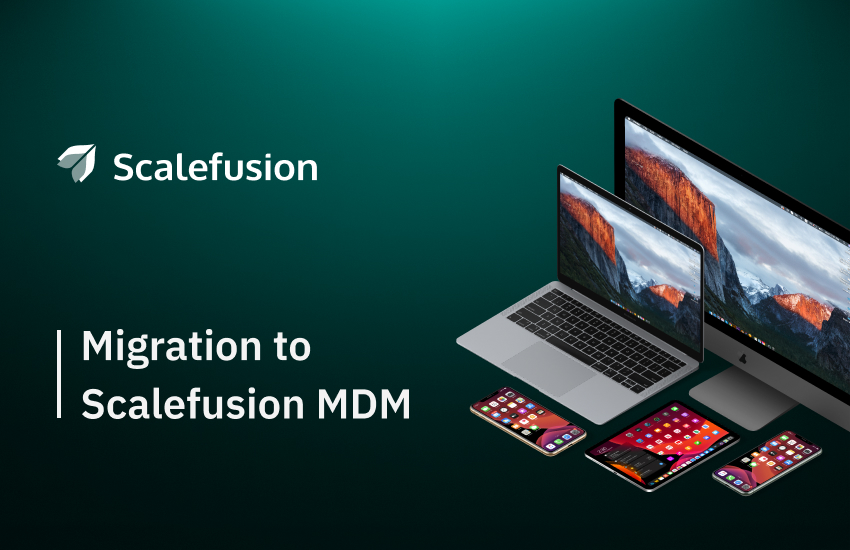Migrating from one mobile device management (MDM) solution to flipside can be a ramified and time-consuming process. There are several challenges that organizations may squatter during this process. One of the main challenges could be data migration. Organizations need to ensure that all of their data is transferred correctly and securely. This includes device profiles, settings, and applications, which can be a time-consuming and difficult task, expressly if the data is stored in variegated formats or systems.

Another rencontre is compatibility. Not all MDM solutions are uniform with all types of mobile devices, operating systems, and platforms. Organizations need to ensure that their new MDM solution is uniform with the devices and operating systems that they use. This may require spare testing and configuration, which can add to the overall forfeit and complexity of the migration.
Maintaining end-user wits when moving from existing MDM is crucial. The migration process can be disruptive for end users, as it may require them to transpiration the way they wangle and use their devices. This can be worrying and lead to frustration and decreased productivity. Organizations need to plan the migration thoughtfully and communicate with end users in whop to minimize disruption.
Another rencontre is the loss of features and functionalities. Some MDM solutions may have features and functionalities that are not present in other solutions. Organizations may need to consider whether they are willing to sacrifice unrepealable features and functionalities in order to migrate to a new MDM solution. IT leaders may need to prioritize essential use cases in their organization surpassing choosing an MDM solution.
Finally, the forfeit is moreover a major challenge. Migrating from one MDM solution to flipside can be expensive. Organizations need to consider the financing associated with purchasing a new solution, as well as the financing of data migration, testing, training, and post-sales support.
Regardless of these challenges, waffly merchantry environments, and transforming physical workplaces, current MDM solutions may be insufficient to meet merchantry needs. In such a situation, migrating to flipside MDM solution makes strong merchantry sense.
Why Switch to Scalefusion MDM?
- Multiple OS support: Scalefusion supports multiple operating systems including Android, Windows, iOS, macOS, and Linux (coming soon). Refer to the pricing page to get a snapshot of Scalefusion’s features.
- Free consumer support: 18/6 consumer support with an stereotype response time of 90 seconds and a first contact resolution of 80% over chat.
- Flexible pricing: Salesfusion is misogynist for organizations of variegated sizes and needs. Organizations have the option to reconfigure batch sizes for establishing a upkeep and purchase licenses only when needed.
- Minimum learning curve: IT administrators do not require any spare training to start managing mobile devices. An intuitive dashboard and straightforward configuration steps midpoint users can start managing devices with minimum handholding.
How to Migrate Devices from One MDM Solution to Scalefusion MDM
While undertaking MDM migration can seem overwhelming, having a checklist will not only help but is crucial for success.
Migration Checklist
- Create a planning guide that includes variegated tasks associated with the migration.
- Evaluate and document all workflows
- Communicate and prepare end users for the migration
- Export resources from the old MDM
- Unenroll or wipe mobile devices
- Import resources and data into Scalefusion MDM
- Re-enroll devices in Scalefusion MDM using the preferred method
- Check inventory to ensure data transfer and device enrollment
MDM migration is a large project. Breaking it lanugo into smaller manageable tasks will help maintain productivity and ensure work completes on time. The unshortened MDM migration process can be split into three stages:
Pre-migration
This is an opportunity to reevaluate your MDM solution to identify gaps (e.g., deprecated features, or lack of features to support new use cases) and potential areas of improvement. Migrating involves certificates, tokens, and interaction with other services. This information must be placid surpassing proceeding with MDM migration.
Migration
After you have finalized the plan, set a project timeline, collated the necessary information, and communicated with end-users, it is time to start the migration process.
- Export Assets. This includes (but is not limited to) Wi-Fi profiles, security certificates, apps, and identity/user hallmark certificates.
- Integrate your directory services like Azure AD, G Suite, and Okta with Scalefusion for largest management.
- Unenroll devices. After exporting the data, uncork removing devices from your current MDM. This may include removing the MDM profiles, uninstalling the wage-earner app, factory resetting mobile devices, or deleting the device directly from the portal.
- Enroll the devices. Scalefusion supports a multitude of device enrollment methods from enrollment invites (email, QR code) to zero-touch enrollment.
Post-migration
After migration, verify the exported device inventory with the inventory in Scalefusion MDM to ensure every device is enrolled and transferred correctly. Conduct surveys to collect user experience. Get in touch with the consumer support team to mitigate any troubleshooting issues.
Wrapping Up
Scalefusion can move company-owned mobile devices by enrolling them in fully managed mode. If you are planning an MDM migration, finger self-ruling to get in touch with our team.
Scalefusion is ISO/IEC 27001:2013 certified, SOC-2 Type-2, GDPR, and HIPAA compliant.
